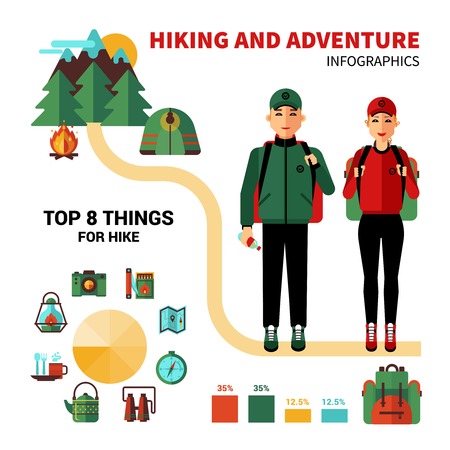Introduction to Hiking Culture in America
America’s love affair with the great outdoors runs deep. From coast to coast, generations of Americans have embraced nature as a source of adventure, relaxation, and inspiration. The country’s vast wilderness areas—ranging from towering mountain ranges and rolling hills to rugged deserts and lush forests—invite millions to step outside and explore. Over time, hiking has become one of the most popular ways for people across the United States to enjoy these spectacular landscapes.
Hiking isn’t just about exercise or ticking off scenic views; it is woven into the fabric of American life. For many, it’s an opportunity to unplug from busy routines, breathe fresh air, and reconnect with friends or family. Whether it’s a quick walk on a local trail or an epic journey along famous routes like the Appalachian Trail or Pacific Crest Trail, hiking brings people together in shared appreciation for nature.
One reason hiking thrives in America is its accessibility. Trails can be found almost everywhere—from urban parks in New York City to remote paths in Montana. This makes it easy for people of all ages and backgrounds to get involved. Many communities also support active hiking clubs that organize group outings, offer safety tips, and foster camaraderie among members. These clubs play a huge role in shaping how Americans experience outdoor adventures and build lasting friendships on the trail.
Why Hiking Is So Popular in the U.S.
| Reason | Description |
|---|---|
| Accessibility | Trails are available in cities, suburbs, and rural areas across the country. |
| Diverse Landscapes | The U.S. offers everything from mountains and forests to deserts and coasts. |
| Community Connection | Hiking clubs help people meet new friends and share outdoor experiences. |
| Health Benefits | Hiking improves physical fitness, mental health, and overall well-being. |
| Cultural Tradition | Spending time outdoors is a cherished part of American culture and history. |
The Role of Hiking Clubs in American Outdoor Life
As hiking continues to gain popularity, clubs across the nation provide structure, encouragement, and social opportunities for both beginners and seasoned hikers. By joining a club, many Americans find not only new trails but also lasting friendships—making each adventure more meaningful.
2. The Rise and Role of Hiking Clubs
The Origins of Hiking Clubs in the United States
Hiking clubs have deep roots in American outdoor culture. The earliest clubs began forming in the late 1800s, inspired by a growing appreciation for nature and public lands. Groups like the Appalachian Mountain Club (founded in 1876) and the Sierra Club (founded in 1892) were pioneers, bringing together people who loved to explore mountains, forests, and trails. These organizations set the stage for today’s vibrant hiking community.
How Hiking Clubs Are Organized
Most hiking clubs in the US are structured as member-driven organizations. They typically have a board or committee that oversees club activities, finances, and long-term goals. Many clubs also rely on volunteers to plan hikes, maintain trails, and organize social events. Membership is usually open to everyone—from complete beginners to experienced hikers—making it easy for anyone to join and get involved.
| Club Type | Main Activities | Typical Membership |
|---|---|---|
| Local Clubs | Day hikes, social events, trail cleanups | Families, solo hikers, students |
| Regional/Statewide Clubs | Multi-day hikes, conservation projects, advocacy work | Outdoor enthusiasts across regions or states |
| National Organizations | Long-distance trail maintenance, policy influence, nationwide events | Members from all over the country |
The Mission Behind Hiking Clubs
The heart of most hiking clubs is a shared mission: to make outdoor recreation accessible, safe, and enjoyable for everyone. Some focus on environmental stewardship by maintaining trails or protecting natural habitats. Others prioritize building community and fostering lifelong friendships through group adventures. Many clubs also promote responsible hiking practices—like “Leave No Trace”—to ensure America’s wild places stay beautiful for future generations.
The Impact of Hiking Clubs on Outdoor Recreation
Hiking clubs have played a huge role in shaping how Americans experience the outdoors. They offer guidance for newcomers, host training sessions on safety and navigation, and provide a built-in group of friends to explore with. Their efforts help keep trails open and well-marked while advocating for access to public lands. Thanks to these clubs, millions of Americans find it easier—and more fun—to get outside and connect with both nature and each other.

3. Community and Camaraderie on the Trail
Hiking clubs do much more than organize outdoor adventures—they create a unique sense of community that shapes friendships and welcomes people from all walks of life. When you join a hiking club in the U.S., you’re not just signing up for a trail walk; you’re stepping into a supportive network where everyone shares a love for nature and exploration.
Building Friendships Beyond the Trail
One of the biggest draws of hiking clubs is the opportunity to make new friends. Whether you’re a seasoned hiker or just getting started, these clubs help break the ice. Members often share laughs, stories, snacks, and even help each other through tough climbs. These shared experiences create strong bonds—friendships formed on the trail often last long after the hike is over.
How Hiking Clubs Foster Belonging
For many Americans, joining a hiking club offers a real sense of belonging. Many clubs have regular meetups, potlucks, or gear swaps that bring members together off the trail too. This welcoming atmosphere makes it easy for newcomers to feel at home, no matter their background or skill level.
Inclusivity and Diversity in Hiking Clubs
Hiking clubs across America are known for embracing diversity and encouraging inclusivity. People of different ages, backgrounds, and abilities are welcome to join in. Some clubs even focus on specific groups—like women-only hikes, LGBTQ+ friendly outings, or family-focused treks—to make sure everyone feels comfortable and represented.
| Club Feature | Description | Impact on Members |
|---|---|---|
| Group Hikes | Organized hikes with set routes and leaders | Encourages teamwork and social interaction |
| Themed Events | Special hikes like sunrise walks or wildlife spotting | Makes activities fun and accessible to all interests |
| Diversity Initiatives | Programs supporting various communities (e.g., women’s hikes) | Promotes inclusivity and sense of representation |
| Mentorship Programs | Pairing experienced hikers with beginners | Builds confidence and lasting relationships |
| Community Service Projects | Trail clean-ups, charity events, conservation work | Bonds members while giving back to nature |
The American hiking club experience goes far beyond walking through forests or climbing mountains—it’s about sharing those moments with others, learning from one another, and building lifelong connections along the way.
4. Conservation, Stewardship, and Education
Hiking Clubs: Protecting the Great Outdoors
Across the United States, hiking clubs are much more than just groups for outdoor enthusiasts. These organizations play a big role in keeping America’s natural spaces beautiful, healthy, and accessible for everyone. Their commitment to conservation and stewardship is a true reflection of American values—taking care of the land so future generations can enjoy it too.
Environmental Protection in Action
Many hiking clubs partner with local and national parks to help protect fragile ecosystems. They organize clean-up days, remove invasive plant species, and educate members about minimizing their impact on nature. This hands-on approach not only keeps trails safe and scenic but also helps preserve wildlife habitats and water sources.
How Hiking Clubs Contribute to Environmental Protection
| Activity | Description | Impact |
|---|---|---|
| Trail Clean-ups | Picking up trash and litter along trails | Keeps trails clean and protects wildlife from harmful waste |
| Restoration Projects | Planting native trees and removing invasive plants | Maintains healthy ecosystems and prevents erosion |
| Leave No Trace Workshops | Teaching members about responsible outdoor ethics | Reduces human impact on nature and spreads awareness |
| Advocacy Efforts | Lobbying for trail funding and public land protection | Supports long-term preservation of outdoor spaces |
The Heart of Stewardship: Trail Maintenance and Improvement
A key responsibility embraced by many hiking clubs is trail maintenance. Volunteers regularly check trail conditions, repair signs, clear fallen branches, and build footbridges. Their hard work ensures that trails remain safe and enjoyable for everyone—from families out for an afternoon walk to serious backpackers exploring remote wilderness areas.
Common Trail Maintenance Tasks by Hiking Clubs
- Mending eroded paths with gravel or wood chips
- Installing or fixing trail markers for navigation
- Pruning overgrown brush to keep paths clear
- Building steps or boardwalks in tricky sections
- Reporting hazards like downed trees or damaged bridges to park authorities
Outdoor Education: Passing Knowledge Forward
Education is another pillar of most hiking clubs’ missions. Many offer beginner hikes with experienced leaders who teach basic skills like map reading, first aid, and safe wildlife encounters. Some clubs even run youth programs or collaborate with schools to introduce kids to the joys of hiking and caring for nature.
Examples of Educational Activities:
- Navigational Skills Classes: Using a compass, reading topographic maps, and GPS basics.
- Wildlife Identification Walks: Learning about native plants and animals along the trail.
- Sustainable Hiking Seminars: Tips on reducing waste, packing smart, and respecting the environment.
- Youth Adventure Days: Special outings designed to inspire the next generation of outdoor stewards.
The dedication shown by hiking clubs in conservation, stewardship, and education helps ensure that America’s wild places remain vibrant—not just today but for years to come. These efforts bring people together, deepen connections to nature, and uphold the spirit of looking after the land we all share.
5. Shaping Future Adventures and Lasting Bonds
Hiking clubs in America do much more than organize group hikes—they shape the way people experience the outdoors for a lifetime. By joining these clubs, members find inspiration to try new trails, develop outdoor skills, and build confidence for solo adventures. These experiences often spark a lifelong love of nature and exploration that goes well beyond club activities.
Personal Growth Through Hiking Clubs
Being part of a hiking club allows individuals to learn from seasoned hikers, discover hidden gems in national parks or local preserves, and challenge themselves with hikes they might never attempt alone. The shared knowledge within these groups helps everyone become better prepared and more adventurous in their own journeys.
How Hiking Clubs Influence Individual Adventures
| Influence | Example |
|---|---|
| Skill Building | Learning how to read maps, use a compass, or pack for multi-day trips |
| Confidence Boosting | Tackling harder trails with group support before trying them solo |
| Trail Discovery | Finding less-crowded or off-the-beaten-path routes shared by experienced members |
| Environmental Appreciation | Gaining respect for Leave No Trace principles and conservation efforts |
Lifelong Passions and Friendships
The bonds formed on the trail often lead to deep friendships that last for years. Whether it’s sharing stories around a campfire or planning annual backpacking trips together, many club members say these connections are just as valuable as the hikes themselves. For some, hiking clubs become like a second family—a supportive community that shares their passion for adventure.
Leaving a Legacy of Outdoor Love
Hiking clubs play an important role in passing down traditions and fostering respect for America’s wild places. Members often mentor newcomers, organize clean-up events, or advocate for trail preservation. Through these efforts, they help ensure that future generations can enjoy the same breathtaking landscapes and open spaces. In this way, hiking clubs leave a lasting legacy—not just of miles hiked, but of friendships made and wild places cherished.


